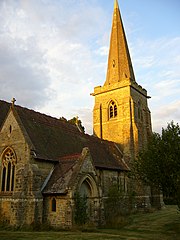Hammerwood
| Hammerwood | |
|---|---|
 St Stephen's Church, Hammerwood |
|
| Hammerwood shown within East Sussex | |
| Area | 8.5 km2 (3.3 sq mi) |
| Population | 200 |
| • Density | 60/sq mi (23/km2) |
| OS grid reference | TQ438391 |
| • London | 28 miles (45 km) NNW |
| District | |
| Shire county | |
| Region | |
| Country | England |
| Sovereign state | United Kingdom |
| Post town | EAST GRINSTEAD |
| Postcode district | RH19 |
| Dialling code | 01342 |
| Police | Sussex |
| Fire | East Sussex |
| Ambulance | South East Coast |
| EU Parliament | South East England |
| UK Parliament | |
Hammerwood is a hamlet in the civil parish of Forest Row in East Sussex, England. Its nearest town is East Grinstead, which lies approximately 3.5 miles (5.6 km) west from the village. The village is situated on the High Weald, on the East Sussex-West Sussex-Kent border.
The village's name is derived from connections to the Wealden iron industry, and a reference to the hammer used in the furnace of the iron forge. A Romano-British iron bloomery (now listed as a site of historic interest) was located near the ponds to the south-east of where the modern village – which did not exist at the time – is located, and a blast furnace existed on another site nearby from at least the 1500s. Areas of nearby woodland are similarly named, including Hammer Wood, Cansiron Wood and Cinder Wood. The settlement was, for several centuries, the central part of an estate known as The Bower, and is believed to have comprised part of a medieval deer park.
In 1792, a site to the south-east of the nucleus of the current settlement was selected by architect Benjamin Henry Latrobe and his commissioner, John Sperling, as the location on which they would build Hammerwood Park, a country house which was one of the first examples of Greek Revival architecture in Great Britain (it was Sperling who originally coined the name 'Hammerwood'). Many of the buildings which form part of Hammerwood today were constructed in the 19th century as tied cottages to support the Hammerwood estate, which at that time consisted of c. 2,500 acres; Oswald Augustus Smith provided in 1864 for a Hammerwood Cricket Club; in 1873 for a village school for 100 children; in 1875 for the Vicarage, and in 1880 for St Stephen's Church, Hammerwood – to the design of E. P. Loftus Brock – at the cost of £7,431 (the first vicar being Rev. Clement Colby Woodland of Corpus Christi College, Cambridge), as well as for a number of other buildings in Holtye and East Grinstead. On 9 July 1880, an ecclesiastical parish of Hammerwood was duly formed from portions of those of East Grinstead and Hartfield. The population of Hammerwood reached a peak of 438 in 1891. St Stephen's Church contains a two manual pipe organ, built by the firm of T. C. Lewis.
...
Wikipedia

